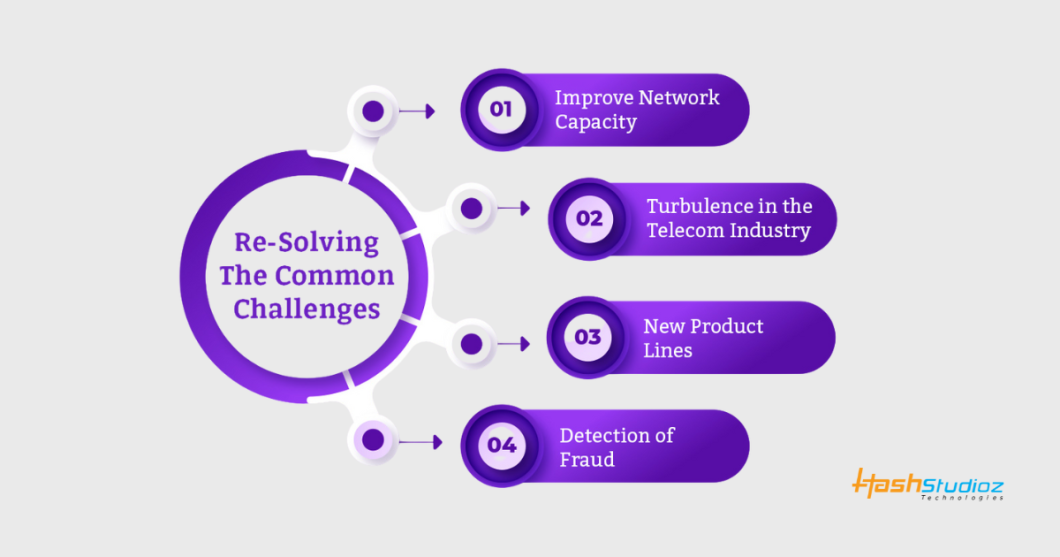As noted by GSMA Intelligence, telecom companies generate about 2.5 quintillion bytes of data each day. Furthermore, IDC estimates that global data volume is expected to reach 175 Zettabytes by 2025, mostly attributed to mobile and IoT spending.
Telecommunications companies have to contend with colossal amounts of data in this ever-evolving digital era. The correct use of this data is essential for optimizing functions, bettering customer satisfaction, and increasing revenue. These insights can be easily facilitated through data analytics services. In this article, we look at ten impactful uses of telecom data analytics that prove their value to businesses.
Table of Contents
- 1. Network Optimization
- 2. Customer Experience Enhancement
- 3. Fraud Detection and Prevention
- 4. Churn Prediction and Management
- 5. Revenue Assurance
- 6. Network Planning and Expansion
- 7. Customer Segmentation and Targeted Marketing
- 8. Predictive Maintenance
- 9. Quality of Service (QoS) Monitoring
- 10. Regulatory Compliance
- Resolving Common Challenges in the Telecom Industry with Data Analytics
- Why Choose HashStudioz for Telecom Data Analytics?
- Conclusion
1. Network Optimization
Telecom networks face constant pressure from increasing user demand. Data analytics helps companies analyze traffic patterns, predict congestion, and optimize bandwidth distribution. This results in improved data speed, reduced latency, and fewer outages. It also supports smarter infrastructure investments by highlighting high-usage areas that need upgrades. Companies reduce costs while improving service quality and user satisfaction.
Benefits:
- Enhanced Performance: By analyzing traffic patterns, companies can alleviate bottlenecks, ensuring faster data transmission speeds.
- Cost Efficiency: Optimizing network resources reduces operational expenses associated with over-provisioning.
Example: Verizon’s use of generative AI predicts call reasons and matches customers with appropriate agents, aiming to reduce churn and enhance loyalty.
2. Customer Experience Enhancement
Analyzing customer interaction data allows telecom companies to understand preferences, behavior, and pain points. Using this insight, they can personalize services, predict complaints, and resolve issues proactively. Faster response times and tailored solutions lead to increased satisfaction. With real-time feedback and automated responses, companies can enhance user experience and maintain a competitive advantage in a service-driven market.
Benefits:
- Personalized Services: Tailoring offerings to individual preferences enhances customer engagement.
- Proactive Issue Resolution: Identifying potential service disruptions before they affect customers demonstrates a commitment to quality.
Example: T-Mobile’s collaboration with OpenAI led to IntentCX, an AI platform that automates customer service tasks and predicts network issues, enhancing user experience.
3. Fraud Detection and Prevention
Fraudulent activity, such as SIM cloning and fake call rerouting, costs telecoms billions each year. With analytics, unusual usage patterns are detected in real time, triggering alerts for investigation. Machine learning models adapt and evolve with new fraud tactics. As a result, telecom providers can reduce financial losses and protect customer data more effectively and rapidly.
Benefits:
- Real-Time Detection: Monitoring transactions helps identify suspicious activities instantly.
- Reduced Financial Losses: Minimizing revenue loss associated with fraudulent actions protects the bottom line.
Example: Machine learning algorithms analyze call patterns to effectively detect and prevent fraudulent activities in telecom networks.
4. Churn Prediction and Management
Churn prediction uses behavioral data to identify customers likely to leave a service. Indicators include frequent complaints, payment delays, or declining usage. Analytics models flag these risks early, enabling timely retention efforts like discounts or better plans. Retaining customers is significantly more cost-effective than acquiring new ones, making churn prediction essential for long-term profitability and growth.
Benefits:
- Targeted Retention Efforts: Focusing resources on customers most likely to leave increases retention rates.
- Improved Customer Loyalty: Personalized retention strategies enhance engagement and loyalty.
Example: By analyzing customer data, telecom providers can identify patterns indicative of potential churn and proactively address issues to retain subscribers.
5. Revenue Assurance
Revenue leakage occurs when there are gaps in billing, service delivery, or usage tracking. Analytics ensures that every service used is correctly billed. By cross-checking records and usage patterns, companies can prevent overcharges, undercharges, or missed billing opportunities. This strengthens financial integrity, increases trust, and recovers potentially lost income through automated checks and real-time corrections.
Benefits:
- Accurate Billing: Ensuring customers are billed correctly reduces disputes and enhances trust.
- Financial Integrity: Protecting against revenue loss due to billing errors or fraud maintains financial stability.
Example: Data analytics help telecom companies monitor billing processes, detect anomalies, and ensure revenue is accurately captured.
6. Network Planning and Expansion
Analytics enables telecom companies to plan network expansions based on real usage data and population trends. This eliminates guesswork when deciding where to install new towers or upgrade infrastructure. Historical traffic patterns and future demand projections help allocate resources efficiently. The result is optimized coverage, better user experience, and reduced capital waste on unnecessary investments.
Benefits:
- Strategic Expansion: Identifying areas with high demand allows for targeted network enhancements.
- Resource Optimization: Allocating resources effectively supports sustainable network growth.
Example: Geospatial analysis enables telecom companies to determine optimal locations for new towers, enhancing coverage and service quality.
7. Customer Segmentation and Targeted Marketing
Segmenting customers using data allows telecoms to design tailored marketing strategies. Users are grouped by behavior, location, usage type, or service preferences. This helps deliver personalized offers that increase engagement and conversions. For example, heavy data users may receive custom mobile plans. These targeted efforts enhance brand loyalty and boost revenue from highly specific customer groups.
Custodial vs. Non-Custodial Wallets: Understanding the Difference
Benefits:
- Effective Campaigns: Delivering relevant promotions to appropriate customer segments increases campaign effectiveness.
- Increased Conversion Rates: Targeted offers enhance the likelihood of customer engagement and sales.
Example: Analyzing customer behavior allows telecom companies to offer personalized promotions, such as discounts on frequently used services.
8. Predictive Maintenance
Telecom equipment failure leads to downtime and service complaints. Predictive analytics uses real-time and historical data to detect warning signs before failures happen. Engineers can schedule maintenance during off-peak times, reducing disruption. This predictive model increases hardware life, reduces operational costs, and improves uptime. It turns reactive maintenance into a proactive and efficient routine.
Benefits:
- Reduced Downtime: Proactively addressing equipment issues prevents service interruptions.
- Cost Savings: Efficient maintenance scheduling lowers operational costs and extends equipment lifespan.
Example: By analyzing equipment performance data, telecom companies can predict failures and perform maintenance to ensure continuous service delivery.
9. Quality of Service (QoS) Monitoring
Telecoms must maintain high service quality to keep customers satisfied. Analytics constantly monitors key performance indicators like signal strength, call drop rates, and download speeds. When performance dips, systems can auto-adjust resources or notify engineers. This ensures consistent quality, supports service-level agreements (SLAs), and reduces user complaints. Continuous QoS analysis builds customer trust and loyalty.
Benefits:
- Enhanced User Experience: Maintaining high-quality service delivery keeps customers satisfied.
- Operational Insights: Data-driven guidance informs network enhancements and resource allocation.
Example: Real-time analytics help monitor network traffic, allowing telecom companies to adjust resources to maintain optimal service quality.
10. Regulatory Compliance
Telecoms must meet strict data privacy and operational regulations. Analytics tools help track data usage, user consent, storage practices, and reporting. Automated compliance dashboards alert teams to non-conformities. This avoids fines, protects the company’s reputation, and ensures alignment with laws like GDPR. Data analytics makes compliance more manageable and ensures telecoms remain legally sound and customer-focused.
Benefits:
- Compliance Assurance: Adhering to legal and regulatory standards avoids penalties and reputational harm.
- Risk Mitigation: Monitoring data practices reduces the likelihood of legal and financial repercussions.
Example: Analytics tools track data handling practices, ensuring that telecom companies meet regulatory requirements and maintain customer trust.
Resolving Common Challenges in the Telecom Industry with Data Analytics
1. Improving Network Capacity
As the number of connected devices grows, telecom networks must handle rising data loads. Data analytics helps telecom providers forecast traffic demand based on historical usage and real-time data. This allows for capacity planning, such as upgrading infrastructure where usage is high and offloading traffic from congested zones.
How it helps:
- Predicts peak usage patterns to prevent network overload
- Identifies underutilized regions where resources can be reallocated
- Enhances the quality of service by reducing dropped calls and slow data speeds
Result: Data-driven planning ensures that infrastructure investments improve performance without overspending.

2. Managing Turbulence in the Telecom Industry
The telecom sector faces frequent disruption from changing regulations, new competitors, and shifting customer expectations. Data analytics services provide telecom leaders with real-time insights into market conditions, operational efficiency, and customer sentiment.
How it helps:
- Analyzes competitor pricing and customer churn trends
- Monitors service performance to maintain regulatory compliance
- Measures customer satisfaction to adapt service offerings quickly
Result: Informed decision-making reduces risk and keeps telecom providers adaptable in a fast-changing market.
3. Launching a New Product Line
Introducing new telecom products like 5G plans, IoT packages, or entertainment bundles requires an understanding of market demand and customer behavior. Analytics helps segment audiences and identify high-potential groups for targeted product development.
How it helps:
- Identifies user groups most likely to adopt new services
- Tests new offerings using A/B models and feedback loops
- Monitors real-time uptake and adjusts marketing strategies accordingly
Result: Telecoms can reduce product launch risks and increase the likelihood of adoption by aligning offerings with actual user needs.
4. Detection of Fraud
Fraudulent activities such as SIM swaps, subscription fraud, and international revenue share fraud cost telecoms billions annually. Analytics tools powered by machine learning detect anomalies and flag potential fraud in real time.
How it helps:
- Tracks suspicious call volumes, usage spikes, and irregular patterns
- Uses historical fraud profiles to train detection algorithms
- Sends real-time alerts for immediate investigation and intervention
Why Choose HashStudioz for Telecom Data Analytics?
At HashStudioz, we specialize in data analytics consulting services tailored for the telecom industry. Our experienced teams build advanced, AI-powered platforms that support fraud detection, churn prediction, network monitoring, and customer engagement. We work with telecom providers to develop scalable, secure, and cost-effective analytics infrastructures.
Our comprehensive data analytics services include:
- Custom dashboard development
- Real-time network and service monitoring
- Predictive models for churn and maintenance
- Billing analytics and revenue assurance
- GDPR-ready compliance analytics tools
Ready to Transform Your Telecom Operations?
If your telecom organization is looking to improve operations, reduce losses, and deliver better service through data analytics, HashStudioz is your trusted partner.
Contact HashStudioz today to schedule a free consultation and see how our analytics solutions can support your goals.

Conclusion
The telecom sector operates in a highly competitive, data-heavy environment where service quality, customer retention, and operational efficiency directly impact business outcomes. As telecom networks expand and user expectations increase, relying on intuition or fragmented data handling is no longer viable. The integration of data analytics services enables telecom operators to move from reactive decision-making to proactive, insight-driven strategies.
From network optimization and churn prediction to fraud detection and regulatory compliance, data analytics plays a crucial role in addressing operational challenges. These tools not only ensure service continuity but also improve user experience, increase profitability, and support long-term growth. According to McKinsey, companies that effectively use analytics improve their EBITDA by 15-20%, a figure that’s particularly meaningful for telecoms aiming to retain their market share.

